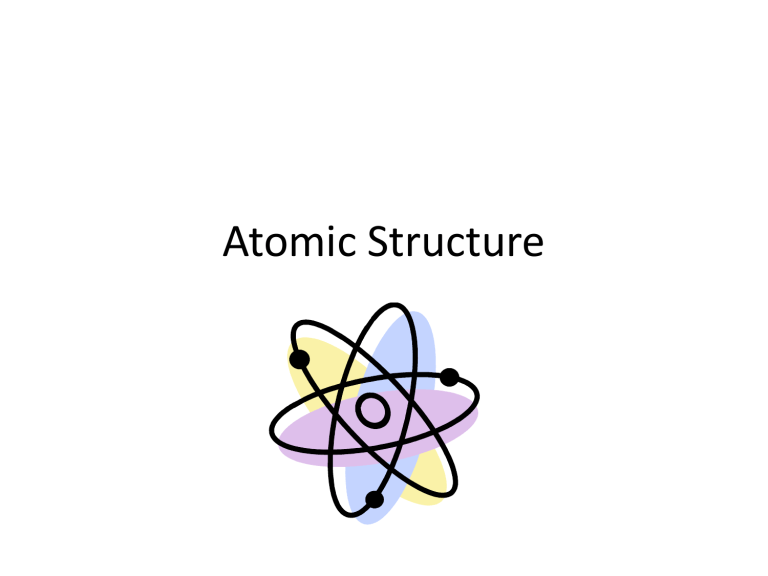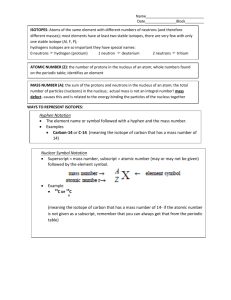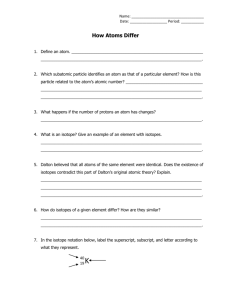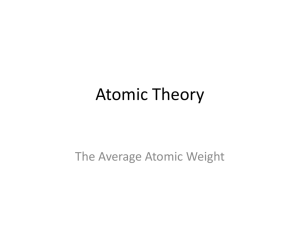Atomic Structure

Atomic Structure
What Is An Atom?
• the smallest particle of an element that retains the chemical properties of that element
• Can be subdivided into electrons (e ), protons
(p + ) and neutrons (n 0 )
Diagram Of An Atom
Important Info About Subatomic
Particles
Particle Relative
Electric Charge
Mass Number Relative Mass
(amu)
Actual Mass
(kg)
Electron (e )
Proton (p + )
Neutron (n o )
-1
+1
0
0
1
1
.0005486
1.007276
1.008665
9.109 x 10 -31
1.673 x 10 -27
1.675 x 10 -27
1 amu = (1/12)(mass of C-12 isotope in kg)
1 amu = 1.660540 x 10 -27 kg
Amu = atomic mass units
Atomic Number (Z)
• Tells us the number of protons in the nucleus of an atom
Z
Isotopes
• Some atoms of the same element will have different masses.
• These atoms are called isotopes because they have the same number of protons, but differ in the number of neutrons.
• Isotopes of the same element have different mass numbers.
• Mass number (A) is the total number of protons and neutrons in the nucleus of an isotope
How Are Isotope Symbols Denoted?
Hyphen Notation of Isotopes
• Isotopes can also be denoted through hyphen notation
• The element symbol will be listed, following a hyphen, and then a mass number (p + + n 0 )
• Ex. Hydrogen has 3 isotopes (H-1, H-2, H-3)
AKA “Protium”
99.985% Abundant
H-1
Hydrogen Isotopes
.015% Abundant
H-2
Radioactive, Prepared
Artifically
H-3
Sample Problems
• How many protons, electrons, and neutrons are there in a Cl-37 atom?
• How many protons, electrons, and neutrons are there in the following isotopes?
-1
Atomic Mass
• What is the atomic mass listed on the periodic table under each element really measuring?
• This mass is a weighted average of all of the naturally occurring isotopes of an element
• This mass is a relative average (compared to the C-12 isotope) in atomic mass units (amu)
How To Find The Atomic Mass of
Hydrogen
H-1 is 99.985% abundant with an atomic mass of 1.007825 amu
H-2 is .015% abundant with an atomic mass of 2.016490 amu
H-3 is not counted because of the fact that it is not naturally occurring
To find the weighted average:
(% abundance/100)(relative atomic mass of isotope 1) +
(% abundance/100)(relative atomic mass of isotope 2) +
(% abundance/100)(relative atomic mass of isotope 3)…
*Mass # may be substituted for the relative atomic mass when given
(99.985%/100)(1.007825 amu) + (.015%/100)(2.016940 amu)
= 1.0079 amu
Things To Remember…
• If you change the number of protons, you change the type of atom itself.
• If you change the number of electrons, you change the atom to an ion (charged particle).
• If you change the number of neutrons, you change the isotope of that element.






